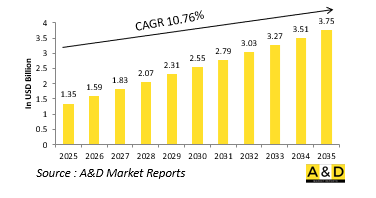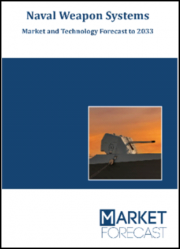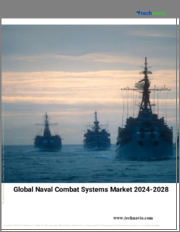
|
시장보고서
상품코드
1719520
세계의 무인 함정 시뮬레이션 시장(2025-2035년)Global Unmanned Naval vessels Simulation Market 2025-2035 |
||||||
세계의 무인 함정 시뮬레이션 시장 규모는 2025년 13억 5,000만 달러로 추정되며, 2035년까지 37억 5,000만 달러로 성장할 것으로 예측되고 있으며, 예측 기간 중(2025-2035년) 연간 평균 성장률(CAGR) 10.76%로 전망되고 있습니다.

무인 함정 시뮬레이션은 해전의 다음 진화를 향해 해상 부대를 준비하는데 있어 급속히 기초가 되고 있습니다. 이러한 시스템은 해군의 작전 계획, 실행, 지원 방법을 바꾸고 있어 원격 조작, 자율성 관리, 시스템 조정에 있어서의 새로운 능력을 필요로 하고 있습니다. 또한 분쟁수역과 제한구역을 포함한 다양한 해양환경에서 부대의 닥트린과 의사결정 프로세스를 테스트하는 것도 가능합니다. 해군은 활동범위를 확대하고, 상황인식을 강화하고, 요원이 위험에 처하는 기회를 줄이는 수단으로서 무인능력을 도입하고 있습니다.
무인 함정 시뮬레이션 시장에서 기술의 영향 :
기술의 진보는 무인 함정 시뮬레이션의 정세를 근본적으로 바꾸고 있으며, 매우 상세하고 응답성이 높은 트레이닝 에코시스템을 가능하게 하고 있습니다. 이러한 플랫폼에는 현재 행동 알고리즘, 센서 퓨전, 통신 프로토콜이 내장되어 있어 오퍼레이터는 원격 미션 실행의 거의 현실적인 시나리오를 체험할 수 있습니다. 충실도가 높은 시각화와 합성 해양 환경은 파도 패턴, 수중 음향, 센서 간섭을 시뮬레이션하고, 지표와 수면 아래의 작전에 현실 적인 조건을 만들어 냅니다. 또한, 사이버전이나 전자 시그니처 관리 툴과의 통합에 의해 무인 함정이 스텔스적으로 동작하거나, 간섭에 저항해야 하는 시나리오에서의 훈련도 가능하게 됩니다. 클라우드에 대응한 아키텍쳐는 훈련에의 액세스를 한층 더 확대해, 세계의 부대가 분산한 미션으로 협력할 수 있도록 합니다. 이러한 기술 혁신에 의해 무인 선박의 훈련은 이론적인 지도에 그치지 않고, 급속하게 진화하는 자율적인 해상 작전의 성질을 밀접하게 반영한, 실천
무인 함정 시뮬레이션 시장의 주요 촉진요인 :
해군의 임무에 있어서의 무인해상시스템에의 의존도의 높아짐이 무인해상시스템 특유의 운용 프로파일에 맞춘 시뮬레이션에 대한 세계 수요를 촉진하고 있습니다. 기존 트레이닝 방법은 원거리이며 혹은 인간의 감시를 최소화하고 운영되는 플랫폼에는 적합하지 않기 때문에 이러한 시스템이 어떻게 작동하고 통신하고 명령에 응답하는지를 이해하기 위해서는 시뮬레이션이 필수적입니다. 시뮬레이션은 유인 플랫폼이나 사령부와 상호 운용성을 최대한 활용하면서, 미스 커뮤니케이션이나 시스템 장애의 리스크를 최소화하는 전술이나 워크플로우의 개발을 지원합니다. 특히 자율성, AI, 해상 센싱 등 기술 혁신의 속도가 빠르기 때문에 지속적인 트레이닝 업데이트가 필요하지만, 이러한 트레이닝은 모듈식 소프트웨어 구동 시뮬레이션 환경을 통해 보다 효율적으로 제공됩니다.
무인 함정 시뮬레이션 시장의 지역 동향 :
무인함정 시뮬레이션에 대한 지역적 접근은 해사상의 우선사항, 방위예산, 기술 도입에 따라 달라집니다. 라이브 버추얼 컨스트럭티브 환경에서 항공, 지상, 해중의 각 에셋과의 상호 운용성을 중시하고 있습니다. 아시아태평양에서는 해상 무인화 능력이 급속히 확대되고 있으며, 시뮬레이션은 지역의 해양 분쟁, 고해역의 감시, 전략적 억제 임무에 대한 대비를 지원합니다. 중동에서는 특히 인프라나 지형에 의해 기존에 배치가 제한되던 항만 경비나 침입 대책 작전에 무인 선박을 통합하기 위해 시뮬레이션이 활용되고 있습니다.
주요 무인 함정 시뮬레이션 프로그램:
영국 해양기술기업 SubSea Craft는 회사의 최신 첨단기술인 MARS(해상자율정찰시스템)를 공식적으로 공개했습니다. MARS는 현재 및 미래의 해상 전투의 운영 요구를 충족시키기 위해 고안된 멀티미션 지원 무인 수상 함정(USV)입니다. 100일이라는 단기간에 개발된 MARS는 신속한 플랫폼 레벨 혁신에 중요한 업적을 남겼습니다. MARS는 최근 세계의 분쟁, 특히 우크라이나 전쟁과 흑해에서의 작전에 의해 초래된 임박한 전술적 요구에 대응하기 위해 설계되었습니다.
본 보고서에서는 세계 무인 함정 시뮬레이션 시장에 대해 조사했으며, 10년간의 부문별 시장 예측, 기술 동향, 기회 분석, 기업 프로파일, 국가별 데이터 등을 정리했습니다.
목차
세계 무인 함정 시뮬레이션 시장 - 목차
세계 무인 함정 시뮬레이션 시장 보고서 정의
세계 무인 함정 시뮬레이션 시장 세분화
지역별
유형별
용도별
구성 요소별
향후 10년간 세계 무인 함정 시뮬레이션 시장 분석
이 장에서는 10년간의 세계 무인 함정 시뮬레이션 시장 분석을 통해 세계 무인 함정 시뮬레이션 시장의 성장, 변화하는 동향, 기술 채용 개요 및 전체 시장 매력에 대한 자세한 개요를 제공합니다.
세계 무인 함정 시뮬레이션 시장 기술
이 부문에서는 이 시장에 영향을 미칠 것으로 예상되는 상위 10개 기술과 이러한 기술이 시장 전체에 미칠 수 있는 영향에 대해 설명합니다.
세계 무인 함정 시뮬레이션 시장 예측
이 시장의 10년간 세계 무인 함정 시뮬레이션 시장 예측은 위의 전체 부문에서 자세히 다룹니다.
지역별 무인 함정 시뮬레이션 시장 동향과 예측
이 부문은 세계의 무인 함정 시뮬레이션 시장에서 지역별 동향, 촉진요인, 억제요인, 과제, 그리고 정치, 경제, 사회, 기술 등의 측면을 망라하고 있습니다. 또한 지역별 시장 예측과 시나리오 분석도 상세하게 다루고 있습니다. 지역 분석의 마지막에는 주요 기업프로파일링, 공급자의 정세, 기업 벤치마킹가 포함되어 있습니다.
북미
촉진요인, 억제요인, 과제
PEST
시장 예측 및 시나리오 분석
주요 기업
공급자 계층의 상황
기업 벤치마킹
유럽
중동
아시아태평양
남미
무인 함정 시뮬레이션 시장의 국가별 분석
이 장에서는 이 시장에서 주요 방어 프로그램을 다루며 이 시장에서 신청된 최신 뉴스와 특허에 대해서도 설명하고, 국가 수준의 10년간 시장 예측과 시나리오 분석에 대해서도 설명합니다.
미국
방어 프로그램
최신 뉴스
특허
이 시장의 현재 기술 성숙도
시장 예측 및 시나리오 분석
캐나다.
이탈리아
프랑스
독일
네덜란드
벨기에
스페인
스웨덴
그리스
호주
남아프리카
인도
중국
러시아
한국
일본
말레이시아
싱가포르
브라질
세계 무인 함정 시뮬레이션 시장 기회 매트릭스
세계 무인 함정 시뮬레이션 시장 보고서에 대한 전문가의 의견
결론
항공 및 방위 시장 보고서에 대해서
JHS 25.05.15The Global Unmanned Naval Vessels Simulation market is estimated at USD 1.35 billion in 2025, projected to grow to USD 3.75 billion by 2035 at a Compound Annual Growth Rate (CAGR) of 10.76% over the forecast period 2025-2035.

Introduction to Unmanned Naval vessels Simulation Market:
Unmanned naval vessels simulation is rapidly becoming a cornerstone in preparing maritime forces for the next evolution in naval warfare. As surface and sub-surface unmanned systems take on more critical roles, ranging from surveillance and reconnaissance to mine countermeasures and anti-submarine operations, training through simulation has emerged as a strategic necessity. These systems are changing how naval operations are planned, executed, and supported, requiring new competencies in remote control, autonomy management, and system coordination. Simulation provides a realistic and risk-free platform for operators, mission planners, and technical personnel to train for both routine operations and complex scenarios involving autonomous and remotely piloted vessels. It also enables forces to test doctrines and decision-making processes in a variety of maritime environments, including contested waters and restricted zones. Unlike manned ship simulation, training for unmanned operations must emphasize human-machine interaction, real-time data interpretation, and command decision loops influenced by artificial intelligence. Globally, navies are embracing unmanned capabilities as a way to extend reach, enhance situational awareness, and reduce exposure of personnel to danger. In this context, simulation serves not only as a training tool but also as an operational enabler, ensuring that unmanned platforms are deployed effectively, safely, and in alignment with broader naval strategies.
Technology Impact in Unmanned Naval vessels Simulation Market:
Technological advances are fundamentally transforming the landscape of unmanned naval vessels simulation, enabling highly detailed and responsive training ecosystems. One of the most significant shifts lies in the ability to model autonomous decision-making processes, simulating how unmanned systems react to dynamic maritime environments without human input. These platforms now incorporate behavioral algorithms, sensor fusion, and communication protocols that allow operators to experience near-real scenarios of remote mission execution. Simulators can mimic a variety of operational contexts, such as swarm coordination, denied communications zones, and multi-platform tasking, offering insight into both the capabilities and limitations of unmanned naval assets. High-fidelity visualizations and synthetic oceanographic environments simulate wave patterns, underwater acoustics, and sensor interference, creating realistic conditions for surface and sub-surface operations. Integration with cyber warfare and electronic signature management tools also allows users to train in scenarios where unmanned vessels must operate stealthily or resist interference. Cloud-enabled architecture further expands training accessibility, allowing global forces to collaborate on distributed missions. These innovations ensure that unmanned vessel training is not confined to theoretical instruction but is grounded in practical, adaptable, and mission-relevant experiences that closely reflect the rapidly evolving nature of autonomous maritime operations.
Key Drivers in Unmanned Naval vessels Simulation Market:
The increasing reliance on unmanned maritime systems across naval missions is driving the global demand for simulation tailored to their unique operational profiles. One of the core motivators is the need for scalable, repeatable training that prepares personnel to manage and supervise autonomous vessels in both permissive and contested environments. Traditional training methods are ill-suited for platforms that operate at long range or with minimal human oversight, making simulation essential to understanding how these systems function, communicate, and respond to commands. Another factor is the shift in naval strategy toward persistent surveillance, distributed operations, and low-signature missions, roles that unmanned vessels are uniquely suited to perform. Simulation supports the development of tactics and workflows that maximize these advantages while minimizing the risk of miscommunication or system failure. As these systems are often integrated into larger battle groups or coastal defense networks, simulation helps operators rehearse interoperability with manned platforms and command centers. Additionally, the rapid pace of technological change-particularly in autonomy, AI, and maritime sensing-requires continuous training updates, which are more efficiently delivered through modular, software-driven simulation environments. These drivers make simulation a central component in preparing naval forces for the challenges and opportunities of unmanned surface and sub-surface operations.
Regional Trends in Unmanned Naval vessels Simulation Market:
Regional approaches to unmanned naval vessels simulation vary based on maritime priorities, defense budgets, and technological adoption. In North America, robust investments in unmanned platforms have led to advanced simulation programs focused on autonomy testing, swarm tactics, and integration into joint maritime operations. These simulations emphasize interoperability with air, surface, and undersea assets, often within live-virtual-constructive environments. In Europe, simulation is being used to enhance collaborative development among allied navies, particularly in coastal surveillance, environmental monitoring, and hybrid warfare contexts. Cross-nation exercises are supported by networked simulation systems that allow shared scenario development and real-time team training. The Asia-Pacific region is experiencing a rapid expansion in unmanned maritime capabilities, with simulation supporting readiness for regional maritime disputes, high-seas monitoring, and strategic deterrence missions. Localized training content reflects diverse maritime geography and traffic complexities. In the Middle East, simulation is being used to integrate unmanned vessels into harbor security and counter-infiltration operations, especially where infrastructure or terrain limits traditional deployment. Emerging markets in Africa and Latin America are leveraging partnerships and international collaborations to introduce simulation platforms that enhance their capacity to protect exclusive economic zones and conduct multi-mission patrols with fewer operational risks and reduced manpower requirements.
Key Unmanned Naval vessels Simulation Program:
British maritime technology firm SubSea Craft has officially revealed its latest advanced innovation: the MARS (Maritime Autonomous Reconnaissance System), a multi-mission uncrewed surface vessel (USV) designed to meet the operational needs of both current and future maritime warfare. Developed in a swift 100-day timeframe, MARS represents a significant achievement in rapid platform-level innovation. It has been engineered to address pressing tactical requirements informed by recent global conflicts, particularly the war in Ukraine and operations in the Black Sea.
Table of Contents
Global Unmanned Naval vessels Simulation Market - Table of Contents
Global Unmanned Naval vessels Simulation market Report Definition
Global Unmanned Naval vessels Simulation market Segmentation
By Region
By Type
By Application
By Component
Global Unmanned Naval vessels Simulation market Analysis for next 10 Years
The 10-year Global Unmanned Naval vessels Simulation market analysis would give a detailed overview of Global Unmanned Naval vessels Simulation market growth, changing dynamics, technology adoption overviews and the overall market attractiveness is covered in this chapter.
Market Technologies of Global Unmanned Naval vessels Simulation
This segment covers the top 10 technologies that is expected to impact this market and the possible implications these technologies would have on the overall market.
Global Unmanned Naval vessels Simulation market Forecast
The 10-year Global Unmanned Naval vessels Simulation market forecast of this market is covered in detailed across the segments which are mentioned above.
Regional Unmanned Naval vessels Simulation market Trends & Forecast
The regional Global Unmanned Naval vessels Simulation market trends, drivers, restraints and Challenges of this market, the Political, Economic, Social and Technology aspects are covered in this segment. The market forecast and scenario analysis across regions are also covered in detailed in this segment. The last part of the regional analysis includes profiling of the key companies, supplier landscape and company benchmarking. The current market size is estimated based on the normal scenario.
North America
Drivers, Restraints and Challenges
PEST
Market Forecast & Scenario Analysis
Key Companies
Supplier Tier Landscape
Company Benchmarking
Europe
Middle East
APAC
South America
Country Analysis of Access Control Market
This chapter deals with the key defense programs in this market, it also covers the latest news and patents which have been filed in this market. Country level 10 year market forecast and scenario analysis are also covered in this chapter.
US
Defense Programs
Latest News
Patents
Current levels of technology maturation in this market
Market Forecast & Scenario Analysis
Canada
Italy
France
Germany
Netherlands
Belgium
Spain
Sweden
Greece
Australia
South Africa
India
China
Russia
South Korea
Japan
Malaysia
Singapore
Brazil
Opportunity Matrix for Global Unmanned Naval vessels Simulation market
The opportunity matrix helps the readers understand the high opportunity segments in this market.
Expert Opinions on Global Unmanned Naval vessels Simulation market Report
Hear from our experts their opinion of the possible analysis for this market.















